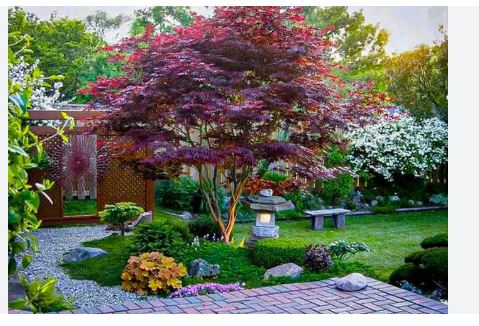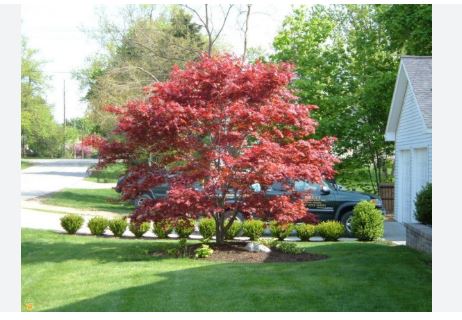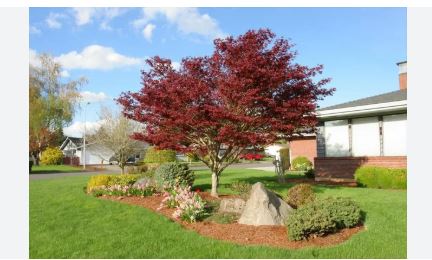
The Bloodgood Japanese Maple (Acer palmatum ‘Bloodgood’) is a captivating deciduous tree, cherished for its striking red-purple foliage, compact form, and elegant aesthetic, making it a cornerstone of ornamental gardening. A cultivar of the Japanese Maple, native to East Asia, this tree transforms landscapes with its vibrant seasonal colors and delicate, lacy leaves, ideal for small gardens, patios, and urban settings.
Its rich history and cultural significance in Japanese horticulture, combined with its versatility, have made it a global favorite among gardeners and designers. In this detailed guide, we explore the botanical classification, history and native area, identifying characteristics, habitat, distribution, USDA hardiness zones, uses, and fascinating facts about the Bloodgood Japanese Maple.
Botanical Classification, History and Native Area
The Bloodgood Japanese Maple, scientifically named Acer palmatum ‘Bloodgood’, belongs to the Sapindaceae family, which includes maples, horse chestnuts, and lychees. The genus Acer encompasses over 150 maple species, with Acer palmatum classified in the section Palmata for its palmate leaves. The cultivar name ‘Bloodgood’ denotes a specific selection of A. palmatum, bred for its deep red foliage.
As an angiosperm, it produces flowers and seeds, with a typically monoecious reproductive system, featuring male and female flowers on the same tree. Its taxonomic relatives include other Japanese Maples like ‘Crimson Queen’ and native maples such as the Sugar Maple (Acer saccharum). The Bloodgood’s vibrant, consistent coloration and compact growth distinguish it within the species, earning it a prominent place in ornamental horticulture.
The Bloodgood Japanese Maple is a cultivar of Acer palmatum, native to Japan, Korea, and parts of China and Mongolia, where wild populations grow in temperate forests. The species has been cultivated in Japan for centuries, with records dating to the 7th century, valued in Zen gardens and tea ceremonies for its beauty and symbolism of balance and impermanence.
The ‘Bloodgood’ cultivar was developed in the United States, introduced by Bloodgood Nursery in New York in the early 20th century, selected for its superior red foliage and robust growth compared to other A. palmatum varieties. Its Japanese heritage ties it to cultural practices like momijigari (autumn leaf viewing), while its American origin reflects global horticultural innovation. Today, it is a staple in gardens worldwide, though its parent species’ native populations face pressures from deforestation and climate change.
Identifying Characteristics

The Bloodgood Japanese Maple is a small to medium deciduous tree or large shrub, typically growing 15–20 feet (4.5–6 meters) tall and wide, with a rounded to upright canopy and finely branched structure. Its bark is smooth and gray, becoming slightly furrowed with age. Leaves are opposite, palmate, and deeply lobed (2–4 inches wide) with 5–7 pointed lobes, emerging bright red in spring, maturing to deep red-purple in summer, and turning vivid scarlet in fall.
The tree produces small, inconspicuous purple-red flowers in spring, followed by paired samaras (winged seeds, 0.5–1 inch long) that are red when young, maturing to brown. Its twigs are slender and red, with small, pointed buds, enhancing its delicate, sculptural appeal. The Bloodgood’s consistent red foliage sets it apart from green-leaved or variegated A. palmatum cultivars.
Habitat
The Bloodgood Japanese Maple thrives in temperate landscapes, preferring well-drained, slightly acidic soils (pH 5.5–6.5), typically loamy or sandy, with consistent moisture. It grows best in partial shade, tolerating full sun in cooler climates but requiring protection from intense afternoon sun in warmer regions to prevent leaf scorch.
In its cultivated range, it is planted in gardens, patios, courtyards, and urban settings, where it adapts to moderate pollution but is sensitive to compacted or waterlogged soils. Its parent species grows in forest understories in Japan, and the Bloodgood mimics this preference for dappled light and rich, organic soils. Proper site selection and soil preparation are critical to ensure vibrant foliage and healthy growth, especially in non-native climates.
Distribution
As a cultivated cultivar, the Bloodgood Japanese Maple has no native wild range but is derived from Acer palmatum, native to Japan, Korea, China, and Mongolia. It is widely planted across temperate regions globally, particularly in North America (e.g., United States, Canada), Europe (e.g., UK, Germany), Australia, and New Zealand, where it is a staple in ornamental gardens, nurseries, and urban landscapes.
In the U.S., it is popular in the Northeast, Pacific Northwest, and Midwest, where climates suit its needs. It does not naturalize aggressively like some maples, as its seeds have low germination rates in non-ideal conditions, but it is propagated extensively through grafting or cuttings. Its global distribution reflects its aesthetic appeal and adaptability, driven by horticultural demand and nursery availability.
USDA Hardiness Zones
The Bloodgood Japanese Maple thrives in USDA Hardiness Zones 5–8, tolerating minimum temperatures from -20°F to 10°F (-29°C to -12°C). It excels in temperate climates with cold winters to break dormancy and moderate summers to support foliage health. In Zone 5, it withstands cold with mulch and wind protection, while in Zone 8, it requires shade and irrigation to mitigate heat stress.
Its sensitivity to extreme heat, humidity, and drying winds limits its success in warmer or arid zones, but its cold hardiness and compact size make it ideal for gardens, containers, and urban settings in northern and coastal regions.
Uses
The Bloodgood Japanese Maple is primarily an ornamental tree, valued for its vibrant red-purple foliage, compact form, and year-round beauty, making it a focal point in gardens, patios, and Zen-inspired landscapes. Its moderate size suits small yards, courtyards, and containers, where it adds color and texture alongside evergreens or perennials. Ecologically, its flowers attract pollinators like bees, and its seeds provide food for birds, though its ecological impact is limited compared to native trees.
In landscaping, it is used in Japanese gardens, as a specimen tree, or in group plantings for seasonal drama, with fall foliage rivaling autumn displays of larger maples. The wood, though not commercially significant, is occasionally used for small crafts. Culturally, it evokes Japanese aesthetics, symbolizing resilience and change, and enhances urban spaces by softening hardscapes and providing shade, though its high maintenance needs require planning.
Fun Facts

The Bloodgood Japanese Maple is brimming with fascinating facts that underscore its allure. Its deep red foliage, unlike the green of wild Acer palmatum, was selectively bred to evoke the fiery hues of autumn year-round, earning it nicknames like “red emperor.” In Japan, its parent species inspired the term momiji, meaning “red leaves,” central to autumn leaf-viewing traditions. A mature Bloodgood at Longwood Gardens, Pennsylvania, is a horticultural icon, showcasing its sculptural form.
The tree’s samaras, or “helicopter seeds,” are smaller and redder than those of other maples, adding charm as they spin to the ground. Its leaves, when pressed, are used in Japanese art to create delicate prints. The cultivar’s longevity, often 70–100 years with care, outlasts many ornamental trees. Finally, its ability to thrive in containers makes it a favorite for bonsai and patio gardening, bringing Japanese elegance to small spaces.
Cultivation of Bloodgood Japanese Maple (Acer palmatum ‘Bloodgood’)
Cultivating the Bloodgood Japanese Maple (Acer palmatum ‘Bloodgood’), a stunning deciduous cultivar renowned for its vibrant red-purple foliage and compact, elegant form, is a rewarding endeavor for gardeners, landscapers, and bonsai enthusiasts aiming to enhance small gardens, patios, or urban landscapes with year-round beauty. Originating from the Japanese Maple species native to East Asia, this cultivar thrives in temperate climates, offering striking seasonal color but requiring careful management to maintain its vivid foliage, protect against environmental stress, and ensure longevity.
- Climate Suitability: Bloodgood Japanese Maple thrives in USDA Hardiness Zones 5–8, tolerating minimum temperatures from -20°F to 10°F (-29°C to -12°C). It prefers temperate climates with cold winters to break dormancy and moderate summers to support foliage health. In Zone 8, provide shade and irrigation during hot summers to prevent leaf scorch, as it is sensitive to extreme heat and humidity.
- Site Selection: Choose a location with partial shade, receiving 4–6 hours of filtered or morning sunlight daily, to protect its delicate leaves from scorching while promoting vibrant color. In cooler climates (Zones 5–6), it can tolerate full sun. Ensure the site accommodates its mature size (15–20 feet tall and wide) and avoid planting near heat-reflecting surfaces or windy exposures, which stress the tree.
- Soil Requirements: Plant in well-drained, slightly acidic soil with a pH of 5.5–6.5, preferably loamy or sandy, rich in organic matter to support healthy growth and foliage. The tree is sensitive to compacted or waterlogged soils, which cause root rot. Test soil drainage and amend with organic matter (e.g., compost, peat moss) to enhance fertility, aeration, and moisture retention without saturation.
- Planting Time: The optimal planting seasons are early spring or fall, allowing roots to establish before summer heat or winter cold. Dig a hole twice as wide and as deep as the root ball, positioning the root collar at or slightly above ground level to prevent rot. Backfill with a mix of native soil and compost, tamp gently, and water deeply to settle the roots and eliminate air pockets.
- Watering Needs: Water young trees deeply (1–2 times weekly) for the first 1–2 years to establish a strong root system, keeping soil consistently moist but not soggy. Once established, the tree is moderately drought-tolerant but benefits from regular watering during dry spells, especially in warmer zones, to prevent leaf drop or scorching. Use drip irrigation or soaker hoses to avoid wetting foliage, reducing fungal risks.
- Mulching: Apply a 2–3 inch layer of organic mulch (e.g., shredded bark, wood chips) around the base, extending to the drip line but keeping it 2–4 inches from the trunk to prevent rot and pest issues. Mulch conserves moisture, regulates soil temperature, and mimics the forest floor, supporting root health in gardens or containers. Replenish mulch annually to maintain its benefits.
- Fertilization: Fertilize young trees in early spring with a balanced, slow-release fertilizer formulated for acid-loving plants (e.g., 10-10-10 or 4-8-5), applying at half the recommended rate to promote steady growth without excessive foliage that weakens structure. Mature trees need minimal fertilization in fertile soils, but a light application every 2–3 years can enhance color and vigor. Avoid high-nitrogen fertilizers, which reduce leaf coloration.
- Pruning: Prune in late winter or early spring, when the tree is dormant, to remove dead, damaged, or crossing branches and to maintain its elegant shape, using clean, sharp tools to prevent disease spread. Light pruning enhances airflow and light penetration, critical for foliage health, but avoid heavy cuts, as Japanese Maples are slow to heal and prone to fungal infections. Remove suckers or basal shoots to preserve form.
- Pest and Disease Management: Monitor for pests like aphids, scale, or Japanese beetles, treating infestations with insecticidal soap or neem oil. The tree is susceptible to fungal diseases like verticillium wilt, powdery mildew, and anthracnose, especially in humid or poorly drained conditions; ensure good drainage, improve air circulation, and remove infected debris promptly. Apply fungicides preventatively in high-risk areas, and avoid overhead watering to minimize leaf diseases.
- Spacing: Space trees 15–20 feet apart to accommodate their mature canopy spread, ensuring adequate sunlight and air circulation to promote foliage health and reduce disease risk. For container or small-space plantings, a single tree suffices as a focal point, or plant 10–15 feet apart in groups for a layered effect in larger gardens. Consider their height (up to 20 feet) when planning near structures or pathways.
- Wind Protection: Young Bloodgood Japanese Maples, with shallow to moderate roots, are sensitive to drying winds, which can scorch leaves or stress the tree. Plant in sheltered sites or use windbreaks (e.g., fences, evergreens) in exposed areas. Stake newly planted trees for the first 1–2 years using flexible ties to allow slight trunk movement, strengthening roots, and remove stakes once established to prevent girdling.
- Winter Care: In Zone 5, protect young trees from winter damage by wrapping trunks with burlap to prevent sunscald and frost cracks, and mulching heavily (4–6 inches) around the base to insulate roots. In containers, move pots to sheltered areas or wrap them to protect roots from freezing. Water adequately before freeze-up to prevent dehydration. Mature trees are cold-hardy and require minimal winter care in temperate climates, but monitor for rodent or deer damage.
- Long-Term Growth: Bloodgood Japanese Maples grow slowly to moderately (1–2 feet per year), reaching 15–20 feet at maturity, with lifespans of 70–100 years with proper care, longer than many ornamental trees. Their vibrant foliage, compact form, and sculptural beauty make them ideal for specimen planting, bonsai, or container gardening in small spaces. Regular monitoring for pests, diseases, and environmental stress, combined with attentive care, ensures lasting color and health.